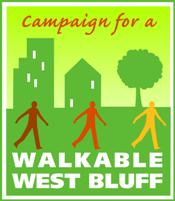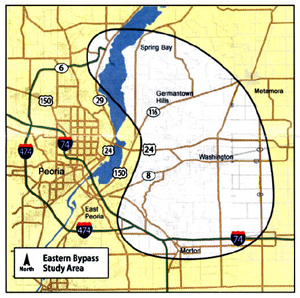I’ve been thinking about this article from the Journal Star — specifically, this information:
Numbers released last week to the Journal Star indicate that in several cases, there is less traffic on I-74 since the Upgrade 74 project was completed in 2006.
East of Adams Street, just off the Murray Baker Bridge, the Illinois Department of Transportation counted an average 56,600 vehicles each day in 2008. Comparably, there were 62,100 vehicles daily crossing the Murray Baker Bridge in 2003, around the time the upgrade project began.
West of Adams Street’s exit, the state counted 51,000 vehicles each day in 2008, compared to 59,100 on average each day in 2003.
In East Peoria, west of the Main Street exit, the 2008 count shows 56,800 vehicles daily, down 3,000 vehicles on average each day from 2003, when the count was 59,800.
My criticism of the Upgrade 74 plan has always been that it was too much. In fact, one of the first posts I wrote (because, like all bloggers, there’s an obligatory post early in our careers complaining about something traffic-related) — on April 18, 2005 — was about the I-74 overhaul:
I’m not denying that the expressway needed some improvements. Some of those exit ramps were very dangerous and needed to be reconstructed.
But isn’t this overhaul a bit excessive? I mean, do we really need six to eight lanes of traffic through Peoria?
It’s almost like they said, “hey, what needs to be done to improve I-74 through Peoria?”
And someone answered, “well, we need to fix those short ramps — especially that dangerous one by the bridge.”
“Yeah, yeah, good! Anything else?”
“Well, it would really help traffic flow to put in a new interchange at Sterling by the mall.”
“Excellent, yes, that would be a good idea. Anything else?”
“Hmmm…. no, not really….”
“Okay, well, what do we estimate that will cost?”
“We figure about $200 million.”
[Furrowed brow] “Well, we’ve got $460 million appropriated… we’re going to have to come up with some more upgrades. What else can we do?”
“Well… uh…. we could add more lanes — and a tunnel — and, and, let’s see how many roads and ramps we can get to intersect at Knoxville — that would be fun!”
And away it went!
Indeed. The Journal Star reported on May 18, 1999, that “The new road will be able to carry up to 100,000 cars a day. Right now, from 30,000 to 65,000 cars use the road daily.” In other words, they doubled the capacity of I-74 through Peoria. Why? There’s no evidence that we needed additional capacity. And now we find out there are fewer cars on the interstate than before the upgrade! More capacity means more maintenance of more infrastructure in a state that can’t pay its bills or maintain its existing infrastructure as it is.
But I guess that’s water under the bridge now. Except I’d like to point out this: As we’re trying to decide what needs to be done with Main Street, let’s remember that traffic engineers are not always accurate in gauging capacity needs. This I-74 overhaul is a very expensive case in point.
 From a press release:
From a press release:
 In the city’s “Issues Update” this week, there was information regarding the upcoming Eastern Bypass study. This is the plan to connect Route 6 and I-474 on the east side of the river, making a ring road — a complete bypass for the greater Peoria area. Here’s the letter IDOT Deputy Director of Highways Joe Crowe wrote to Pekin Mayor Dave Tebben (emphasis mine):
In the city’s “Issues Update” this week, there was information regarding the upcoming Eastern Bypass study. This is the plan to connect Route 6 and I-474 on the east side of the river, making a ring road — a complete bypass for the greater Peoria area. Here’s the letter IDOT Deputy Director of Highways Joe Crowe wrote to Pekin Mayor Dave Tebben (emphasis mine): At Tuesday’s council meeting,
At Tuesday’s council meeting,